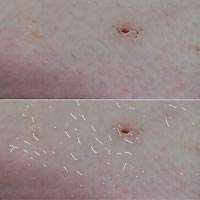Hair today, gone tomorrow: tracking hair loss and growth

(�鶹��ԺOrg.com) -- CSIRO has developed maths-based imaging technology to measure hair on different parts of the human body.
CSIRO’s Biotech Imaging team, who specialise in developing software to analyse images automatically, worked with a UK personal care products company to find a way to objectively test how well their hair removal products work.
Hair counting is often done manually by human assessors.
“It’s a boring job and results are prone to errors and variations between different people,” Dr Pascal Valloton, Leader of Biotech Imaging at CSIRO said.
“Our software uses images captured by a small flatbed scanner pressed onto the skin. The software crunches the numbers to analyse the image of skin and hairs.
“Then, almost instantly, it reports information about the length and number of hairs in the picture.
“You can compare the results with earlier images to see if hair is growing quickly or slowly or has been properly removed by, say, a depilatory cream.”
“The software can even detect hairs that people find hard to see and it’s not confused by variations in background skin colour or texture,” Dr Vallotton said.In the language of image analysis, a hair is called a ‘linear feature’. There are many ways of detecting linear features but this software uses algorithms that exploit some special things about hairs, like their relative straightness.
“The software can even detect hairs that people find hard to see and it’s not confused by variations in background skin colour or texture,” Dr Vallotton said.
The linear feature algorithms the software uses are similar to those developed by the team for medical research to measure the branching structure of nerve cells and to find the boundaries of fat cells.
The hair counting methods, the hardware and the algorithms are described in the November issue of Skin Research and Technology journal
Provided by CSIRO





















